KODAK DCS420 CAMERA
The first look at Kodak's third generation digital camera
by John Henshall
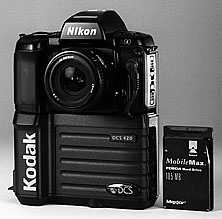
The DCS420 with Maxtor "MobileMax" PCMCIA 105Mb
hard drive.
The DCS420 is Kodak's fourth digital camera based on the Nikon range of 35mm film single lens reflex cameras bodies.
The original DCS, now known as the DCS100, was the first truly portable
- though not totally self contained - professional digital camera
system. It used Nikon's F3 body, and was launched in summer 1991. Images
are stored on a separate 'DSU' - Digital Storage Unit - to which
the camera is connected by a curly umbilical cord. The imaging sensor is
16.4 by 20.5mm with 1024 by 1280 pixels, giving a 1.25 to 1 format identical
to 4 x 5 inch film and close to the format of American quarto paper.
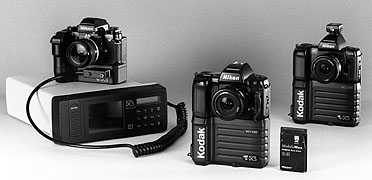
The Kodak DCS family. DCS100 with Digital Storage Unit, DCS
420 and DCS200.
Next came the DCS200, a self-contained camera with built-in 80Mb hard
drive which holds up to 50 images. It was based on the Nikon N8008s body,
known as the 801s in the UK, and used a 9.3 by 14mm imaging chip with 1012
by 1524 pixels - the same aspect ratio (1.5 to 1) as a 35mm SLR frame.
The filtration of the individual pixels was improved over that of the DCS100
chip, resulting in less colour ailiasing - the coloured 'jaggies' somewhat
noticeable on images of man-made subjects. Chief operational drawbacks have
been the slight 'warm up' wait before pictures can be taken and the three
second delay between exposures, while the image is being saved to disk.
Exposure has to be precise: there is no exposure latitude, the DCS200 being
an eight bits per colour device. The camera became available in the fall
(it is American) of 1992. I have used the DCS200 for editorial pictures
for eighteen months. With a little sharpening, followed by processing through
an Agfa filter intended for use with scanners, images printed quarter page
are indistinguishable from film.
Earlier this year [1994] came the Associated Press News Camera, the NC2000, made
exclusively for AP by Kodak. This camera uses the same size and pixel count
chip as that in the DCS100 but with the colour filtration of the DCS200.
It is based on the Nikon N90 body, known as F90 in the UK.
All the subjects below present
difficult tests for a digital camera. Judge for yourself how the DCS420
handles them.
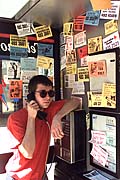
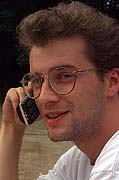
Barnaby Cox of EPIcentre and Glenn Stokes of MacLine discuss the merits of the DCS420.
Hot on its tail now comes Kodak's DC420. In many respects this camera is similar to the NC2000, it too being based on the Nikon N90, but using
the same chip as the DCS200. At first glance the DCS420 looks and feels
similar to the other DCS cameras but its improvements eliminate many of
the criticisms levelled against the DCS100 and 200.
Images are recorded on a removable PCMCIA (Personal Computer Memory Card
International Association) card which slots into the side of the camera.
This is not a solid-state device but a small hard disc drive, the size of
a credit card but 1cm thick, which is presently available in up to 105Mb
capacity, holding about 64 images and costing about £400. A higher
capacity 130Mb card drive is expected later this year. When full, the card
can be removed from the camera very quickly and a new card slotted into
place much faster than you can rewind a cassette and reload a film camera.
This is a major improvement over the DCS200, which got digital constipation
after 50 exposures, rendering it as useless as a car without gas (known
in the UK as petrol) until the images were deleted from the camera's hard
disc, after being downloaded to a host computer.
The DCS420 uses a nickel hydride battery which powers both camera body and
electronics for up to 1,000 exposures. Separate batteries for camera body
and electronics are a thing of the past. Recharging takes no more than an
hour. Even the battery charger connector has been changed, from the DCS200's
damage-prone 2.5mm jack to a 7-pin mini-DIN plug and socket.
'Ready' time to the first exposure is less than a quarter of a second. On-board
DRAM of 8Mb enables the camera to capture a burst of five images in 2.25
seconds before they must be saved onto the PCMCIA drive. This removes the
egg-on-face waiting between exposures associated with the DCS200. Each image
can be annotated with sound, using the microphone built into the camera
back.
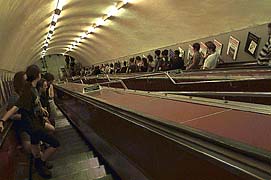
A familiar sight to Londoners and one which presents a big
challenge for a digital camera - fluorescent lighting at low intensity:
Nikkor 18mm lens, DCS420 set to ISO400.
I had hoped that Kodak would have doubled the dimensions of the imaging
chip to 18 x 29mm, while maintaining the same pixel count (and thus manageable
4.5Mb image file size), to save having to use an 18mm lens as 'normal'.
Many observers had expected Kodak's next camera to incorporate the large
- four times the area, four times the number of pixels - 'M6'
chip about which I reported in the January 1994 issue of The Photographer
but the chip used in the DCS420 is the same as that in the DCS200, increasing
the effective focal length of lenses by 2.6 times and presenting a very
small viewfinder image. These digital cameras make wide angle lenses a thing
of the past, though unimaginably long lenses are yours for no extra cost:
my 80-200mm 2.8 Nikkor becomes a 200-500mm 2.8 on the DCS420, enabling me
to make the shot of distant London from Richmond Park.
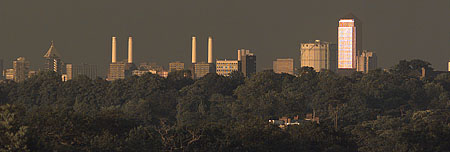
London from Richmond Park, with Battersea Power Station (centre)
6 miles away and Canary Wharf (right) 12 miles away catching the late evening
sunlight.
 Left: The "Info" Box for the shot of London from
Richmond Park.
Left: The "Info" Box for the shot of London from
Richmond Park.
The charge in each pixel of the CCD sensor is now sampled digitally into
4096 levels (using 12 bits) per colour, instead of 256 levels (8 bits) in
the DCS200. This brings to the camera something the previous DCS cameras
simply did not have: exposure latitude. The camera itself decides how best
to sample the 4096 levels down to the 256 levels used by computers. It does
this as it saves the images to the PCMCIA drive. In an attempt to beat the
camera I tried difficult subjects clipped by, or containing, bright highlights.
All the exposures were useable - something which would not have been
the case with the DCS200, which demanded extensive bracketing or careful
exposure with a grey card.
New software makes it possible to 'batch' acquire more than one image at
a time from the camera using the new plug-in for Adobe Photoshop. Expect
further developments in this area, to take more advantage of the 36 bit
capabilities of the camera. A TWAIN driver is supplied for PC applications.
A separate PCMCIA card reader can be attached permanently to a computer,
ending the need to attach the camera itself and making the acquisition of
images much more speedy and convenient. Simply remove the card from the
camera and insert it into the reader. A card reader which will plug into
the second battery slot of Apple Macintosh Powerbooks is expected soon.
The "Aquire" module - a DCS420 plug-in for Adobe
Photoshop.
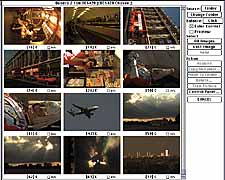
I am most impressed by the quality of the images from the DCS420. The camera is easier to expose than the DCS200 and the images are of higher technical quality, with much less 'noise' in the blue channel and almost
unnoticeable colour ailiasing. I am keeping words to a minimum here, to
allow as the pictures to speak for themselves.

Horse Guards Parade, Whitehall. Plenty of detail and highlights
to test the DCS420 camera.
The camera tested was the DCS420C colour version, which has an ISO range
of 100 to 400. A monochrome version, the DCS420M (ISO 200 to 1600) and infra
red version, DCS420IR, are also available.
Sometimes I wish Kodak would bring out a so-so digital product so that I
could be less enthusiastic about it. All Kodak's digital cameras have been
trail blazers - remarkable leading-edge technology - and I make
no apology for my genuine enthusiasm for the DCS420.
Good as it is, this camera will not yet replace the wide use of film but,
if Kodak maintains its drive to remain at the leading edge of 'instant'
digital photography, a DCS420s descendent will - some day - pay
the wages bill and return healthy profits for both Kodak and its mainline
customers.
This review first appeared as "John Henshall's
Chip Shop" in "The Photographer" magazine, August 1994.
IMPORTANT NOTICE
This document is Copyright © 1996 John Henshall. All rights reserved.
This material may only be downloaded for personal non-commercial use. Please
safeguard the future of online publishing by respecting this copyright and
the rights of all other authors of material on the Internet.









 Left: The "Info" Box for the shot of London from
Richmond Park.
Left: The "Info" Box for the shot of London from
Richmond Park. 
